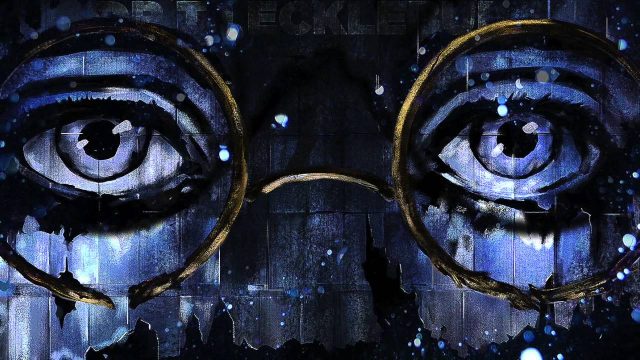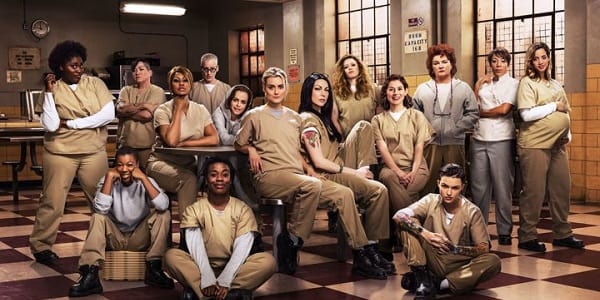
Opting Out of the Male Gaze, WWE meets Orange is the New Black
To borrow from the vocabulary of feminists when referencing popular culture, I would dare say that we live in a heteronormative capitalistic patriarchal sexist society constantly under the watchful eye of the intrusive male gaze. This intangible and omnipresent gaze is Big Brother, except more intensely gendered, unapologetic, and far reaching. What’s more is that the male gaze is not some feature of the latest dystopian novel or new lingo being pioneered by tech-heads, it is a reality we are being made brutally cognizant of in the wake of the myriad of sexual assault allegations flooding the news waves daily. Underlying this concept of the male gaze is the thought that men view the world, and everything in it, as their possessions. The male gaze birthed cat calls, victim blaming, unsolicited groping, and, of course, aided in creating the parameters for what is seen as conventionally beautiful, and what is not. Vice-like in its grip, the male gaze colors most of the visual media we are fed, and when it does not, it alters its focus to coerce us into reading masculinity and machismo onto things which are so evidently and literally not. One need only look as far as the World Wrestling Entertainment, Inc. (WWE) for corroboration about the different permutations the male gaze assumes as it attempts to make sense of people who do not readily fit in to the confines of such a gaze.

A staple in boxing matches is the ring girl, i.e. the girl who, whilst wearing lingerie, struts around the ring in-between rounds to indicate the number of the upcoming round. More often than not, these girls happen to be tall svelte models who offer a brief reprieve from the numerous three minute ordeals featuring hulking pugilists fighting for a purse. In the WWE, the wrestlers in the Women’s Division (divas) are afforded the same courtesy. The WWE’s flagship program, Monday Night Raw, allots a thirty-minute section out of its three hours to these svelte divas who also happen to be dressed in lingerie, oiled, and feature a level of cleavage that could challenge its PG-13 rating. Needless to say, the divas in the WWE take their cues form pornography. Aside from the eerily similar names such as Alexa Bliss, Sasha Banks, Mandy Rose, Mickie James, Candice Michelle, and Chyna, many divas are in fact former pornographic actresses – Candice Michelle, Chyna, and Mickie James chief among them. There seems to be a conscious effort to present these divas in an overtly sexual manner to appease the male gaze. And what is pornography but the ultimate manifestation of scopophilia.
Divas and female pornstars function in the same manner as, “In their traditional exhibitionist role women are simultaneously looked at and displayed, with their appearance coded for strong visual and erotic impact,” (Mulvey 397). The choreographed maneuvers performed in the wrestling ring function as a stand in for the erotic and sensual motions shown in pornographic films. Here, divas, and females in general, are reduced to their most basic form in the male dominated sphere of popular culture—the object. They lack the storylines given to male wrestlers which serve to add depth to their personas; ultimately, the Women’s division offers little more than fighting—coded sexual acts—to pique the interest of the male gaze. Viewers, particularly those at home, now submerge into the Peeping Tom role identified by Laura Mulvey as a sense of satisfaction descends on them from watching the spectacle. Viewing via a screen offers them safe separation and a sense of control knowing that whatever gestures they make will go unnoticed, they are mercy to the whims of no-one but themselves (Mulvey 396).


Yet, not all divas are svelte and fashioned in the mold of Heidi Klum. There are those who weigh over two hundred pounds, stand at six feet tall and are every bit as hulking as their male counterparts. These divas are not lingerie clad. A quick google search for Kharma, Aja Kong, Nia Jax, or Vickie Guerrero will get the point across. Bigger women are not dolled in the same manner as their wiry counterparts. Whether it is down to their muscular frames coloring them more masculine than feminine, or notions of femininity and beauty being too steeped in the idea of the skinny, these women are not aimed at the typical male gaze. These divas are taller, more muscular, and perhaps stronger than the average male. Here, the male gaze is adopting Carol Clover’s one sex principle where, “the men are men and so are the women,” (Clover 14). They are not what women are typically described to be in the patriarchy, therefore, they cannot possibly be women. It is because they are not what we have been normalized to think of as beautiful that the male gaze adopts a different strategy, that is, interpreting these bodies as masculine. Not only do we see it, but the show creators play to this notion themselves. Divas such as Kharma and Nia Jax can be seen growling, shouting, and grunting more than the quintessential diva. More than auditory predatory features is the tendency to incorporate power bombs and fireman carries into their wrestling arsenal; these macho divas use a plethora of lifting maneuvers typically only utilized by male wrestlers which aids in painting them in a more masculine light. There also exists a proclivity to cover up these divas in body suits or any other lengthened apparel that is expressly not lingerie. The WWE is making it known that the fat girl is not in, i.e. the typical male gaze is not intrigued by anything other than skinny model types. The male gaze is offering itself a get-out-of-jail free card; when it cannot readily sexualize or fashion people or things to its liking, it simply assigns them under another heading. For unconventional divas, this means being assigned, referred to and displayed in purely masculine terms.
Then how does one watch Orange is the New Black? Accompanying its fair share of fodder for the male gaze are women with a multiplicity of diverse body types. So much so that the svelte-type can be said to be in the minority, or at least, describes less than half the women in the show. Beyond the eye lies a complex cast of women whose desires and ambitions are not tied to men. There is no fighting for his love, or supporting him, or even getting over him; it is all about her. Orange is the New Black (OITNB) is women surviving a hostile space. It is women existing in an artificial world—a literal prison—designed to keep them in check, i.e. remind them that they are scum. OITNB is womanhood personified. The male gaze is hard-pressed to find its ideal woman and shape her to his desires. Even if she may physically fit the script, the emotional traction given to the characters are such that the are no damsels in distress waiting for Prince Charming, but rather are damsels who cause the distress—given that they are criminals.

OITNB effectively confiscates the get-out-of-jail free card built in to the male gaze. It is unapologetic in its representation of women. It does not adhere to the stigma that, “Females are more likely to be young, thin, and sexualized,” (Smith et al. 19). Littered throughout the sixty-five episodes are shower scenes depicting women in the nude – from petite to plus-sized and more. Unlike the WWE, OITNB is not only broadcasting the ring girls in all their natural glory, but it also refuses to censor the nudity of thicker more corpulent women. The male gaze is being both gratified and challenged simultaneously. OITNB concedes a Piper Chapman or an Alex Voss, quintessential representations of beauty defined by the male gaze, so the audience is getting its quota of women readily made and represented for the consumption of the voyeuristic viewer. But, the audience is also made to consume a Boo, or a V, or any other curvier woman. What disempowers the male gaze here is that it cannot get away with simply reading masculinity on to Boo and V. Why? There nakedness is out in the open for unfiltered consumption. There are no clothes covering up what the audience may desire not to see. Where bigger women within the WWE are covered up or given other identifiers to potentially categorize them as masculine, these bigger women in OITNB have their breasts and other sensual regions out in the open. The male gaze is prompting us to see these unconventional women as masculine in nature, and yet here lies a nude body fitted with female apparatus.
Moments like the aforementioned calls into question the superfluity of the male gaze. I am not questioning if the male gaze exists, as it clearly does. Nor am I calling into doubt its presence in OITNB, for it is surely there. I am merely hypothesizing that there is more; the male gaze is not the be-all and end-all through which popular culture operates. The scopophilia-esque dimension of the male gaze is subdued by the representation of nonconventional women and their expressly feminine features being put on display. Hence, the male gaze can no longer readily fashion whatever its gaze rests upon in a way to please itself and/or fit within its confines. The male gaze then has to turn to on screen representations of males asserting their power.
OITNB unfolds within a prison, thus, the male guards do have power, in an authoritative sense, over the female inmates. This is then a potential avenue for the male gaze to attempt to reassert dominance in a show that it has been sourly subdued. However, as mentioned before, these men are lacking. They are either physically inept, as is the case with C.O. John Bennet who has a prosthetic leg. Or emotionally dysfunctional, as is with the prison counselor Sam Healey who is a cuckold in a marriage of unrequited love. The men are forced to subscribe to a “typical guy-plot about struggling against disillusionment and prejudice to be a good man,” (Berlatsky). They are shown in a position of want, i.e. the male gaze and male audiences are not afforded a typical dominant male lead to identify with; they are not fully developed being either physically or emotionally stunted. And ordinarily this may function as a way to add depth to a character, however, these men are afforded no room to grow but remain caricatured versions of their problems. Through this, OITNB engages in shameless role reversal as the heroic male is castrated, made nonexistent even. The male gaze is then trapped. With all outlets to fully assert its dominance exhausted, a new lens has to be adopted. The idea that, “the decisive moment, as far as the fixing of gender is concerned, lies in what happens next: those who save themselves are male, and those who are saved by others are female,” holds (Clover 59).

The women of OITNB are saving themselves – and that may be the only perceived masculine thing about them. There is no man helping the cancer stricken Rosa escape in season two. There is also no male hero aiding Piper as she confronts Pennsatucky and her Christian gang. When the anxiety attacks and overwhelming waves of depression set in, the inmates turn to each other for support, the prison counselling system—headed by Healey—is ignored. Our sense of men being the hero in the patriarchy is inexplicably turned on its head. OITNB then demands a neutral gaze; a neutral gaze that is neither male, female, nor heterosexual (Walsh). Netflix’s flagship original features as much if not more queer personalities than heterosexual ones. And neither are the actions of the women always overtly sexual. Yes, it is littered with sensual scenes, but it is also littered with the most rudimentary acts of eating, reading, cutting hair, talking and the like. As Walsh points out, even the scenes where sexual intercourse is the focus, isolation shots are nonexistent, i.e. there is no emphasis on the breasts, hips, lips and the like (Walsh). Instead, the entire body is shown focusing more on the character and her experience rather than explicitly feeding into a Peeping Tom’s desire for momentary isolated arousal. Women are doing actions in and of themselves, they are neither doing it for a man nor to promote a feminist agenda, they are simply doing it as a fact of existing in everyday life.

The male gaze is not inescapable. It is invasive and at times unforgiving, but it is not the be-all end-all. The tentacles of the male gaze, though invading, seems unable to fully penetrate spheres which diverge from the heteronormative path. While a sliver is sacrificed here and there to placate the heteronormative capitalist structures which distribute television shows, the overall meal is anything but ideal food for the gaze. There is a lingering sense that the male gaze can be neutralized by presenting a basket of characters (women) that are disturbingly normal, i.e. functions as more than purely sexual beings. Popular culture is a bastion of male domination, but OITNB provides its contemporaries with a formula to exist within such a cage. The nature of how we watch television dictates that we are Peeping Toms, that much is evident, but on the contrary to our conceptions of Peeping Tom being the pervert, we are Peeping Tom the intellect, peeping in to see what life is like when we take the male dictated mask off.
Bibliography
Berlatsky, Noah. “Orange Is the New Black’s Irresponsible Portrayal of Men.” The Atlantic, Atlantic Media Company, 30 June 2014, www.theatlantic.com/entertainment/archive/2014/06/why-it-is-a-bad-thing-that-orange-is-the-new-black-leaves-men-out/373682/. Accessed 9 Dec. 2017.
Clover, Carol J. “Her Body, Himself: Gender in the Slasher Film.” Representations, no. 20, 1987, pp. 187–228. JSTOR, JSTOR, www.jstor.org/stable/2928507. Accessed 9 Dec. 2017.
Mulvey, Laura. “Visual Pleasure and Narrative Cinema.” Screen, vol. 16, no. 3, 1975, pp. 393-403.
Smith, Stacy, et al. “Gender Roles and Occupations: A Look at Character Attributes and Job-Related Aspirations in Film and Television.” Geena Davis Institute on Gender in Media, pp. 1-46.
Schwan, Anne. “Postfeminism Meets the Women in Prison Genre.” Sage Journals: Television & New Media, vol. 17, no. 6, 2016. http://journals.sagepub.com/doi/pdf/10.1177/1527476416647497. Accessed 10 Dec. 2017.
Walsh, Christine. “The ‘Male Gaze’: Have Mainstream Film and Television Really Changed since the 1970s?” Sexualitaetundmedien.wordpress.com, 21 Apr. 2017, sexualitaetundmedien.wordpress.com/2016/07/17/the-male-gaze-have-mainstream-film-and-television-really-changed-since-the-1970s-with-reference-to-orange-is-the-new-black/. Accessed 10 Dec. 2017.